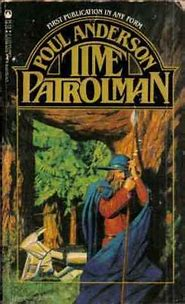-Poul Anderson, "The Sorrow of Odin the Goth" IN Anderson, Time Patrol (Riverdale, NY, 2010), pp. 333-465 AT 43, p. 462.
"'It is but four or five years since the Goths rode down the Romans at Adrianople. Have you heard about that, centurion? The Emperor Valens himself died on the field. Theodosius must buy the alliance of those barbarians, Arian heretics, those that are not still outright heathen -'"
-Roma Mater, p. 24.
Yes, the Time Patrol text had told us that those Goths were Arians and added:
"'A new Emperor, Theodosius, made peace with the Goths in 381, and most of their warriors entered the Roman service as foederati: allies, we'd say.'"
-ibid.
By rereading one Anderson text and remembering another, I have learned some Roman history.

8 comments:
Though the Huns did -not- have stirrups, as (IIRC) one of Poul's stories says.
Those were introduced to Europe by the Avars in the 500's CE, about a century and a half later.
Kaor, Mr. Stirling!
Now I'm surprised, I thought it was heavy cavalry which defeated the Romans at Adrianople. And I thought stirrups were known and used in Europe by then. I did know stirrups and improved saddles made cavalry much more effective.
Ad astra! Sean
Sean: improved saddles came before stirrups. Eg., wooden frames ('trees' as they're technically known) and raised cantles. The Huns -did- have wood-framed saddles; whether the Romans did before then is a matter of dispute.
Heavy cavalry was present and quite effective long before stirrups -- cataphracts, as the Romans called them. The Romans copied them from the Sarmatians and the Parthiana.
The Parthian army that defeated Crassus in 53 BCE at Carrhae was a mix of horse-archers and armored spearmen(*).
But stirrups made it much -more- effective.
Stirrups also made horse-archers more effective, particularly when shooting at the gallop.
(*) nb the 'couched lance' style, with the lance held under the arm and using the momentum of the horse to drive the point home, was a rather late invention.
If you look at the Bayeux Tapestry, which shows the Battle of Hastings, you'll note that the Norman knights were using an overarm stabbing technique with their spears, for the most part.
Kaor, Mr. Stirling!
Got it, greatly improved saddles made for much more effective heavy cavalry and mounted archers by the late fourth century AD. I do recall mention of those cataphracts in THE KING OF YS. With stirrups coming into common use in Europe after 500.
I looked up the Bayeux Tapestry, and I noticed how those Norman knights used that over arm stabbing technique for spears.
Ad astra! Sean
Sean: starting around 500, though they'd been invented in northern China a few centuries earlier.
The first stirrups were single ones used as an aide to mounting. Then paired ones came into use.
They'd spread into western Europe by the 7th century, but -- oddly -- weren't taken up by the Gaelic-speaking Irish, who were still riding without them in the Elizabethan age.
It took quite some time for the possibilities of stirrups and improved saddles to be worked out.
Kaor, Mr. Stirling!
That's what I recalled, from a quick skim thru the Wiki article.
Irish Celts took THAT long to adopt improved saddles and stirrups??? Shocking, when the Bayeux Tapestry shows Norman knights using them!
Ad astra! Sean
Sean: it's weirder than that. The Normans (Anglo-Welsh Normans, specifically) invaded Ireland in 1170, under Strongbow (Richard de Clare). And -they- had stirrups, and used a quite sophisticated set of gear including couched-lance tactics. So the Irish had centuries of experience -fighting- people using modern saddles but many of them didn't use them themselves as late as the 1500's.
It's a puzzle.
Kaor, Mr. Stirling!
And catastrophic for the Irish, this puzzling reluctance to update the ways and means of fighting. As was their equally catastrophic inability to form a unified state.
Ad astra! Sean
Post a Comment